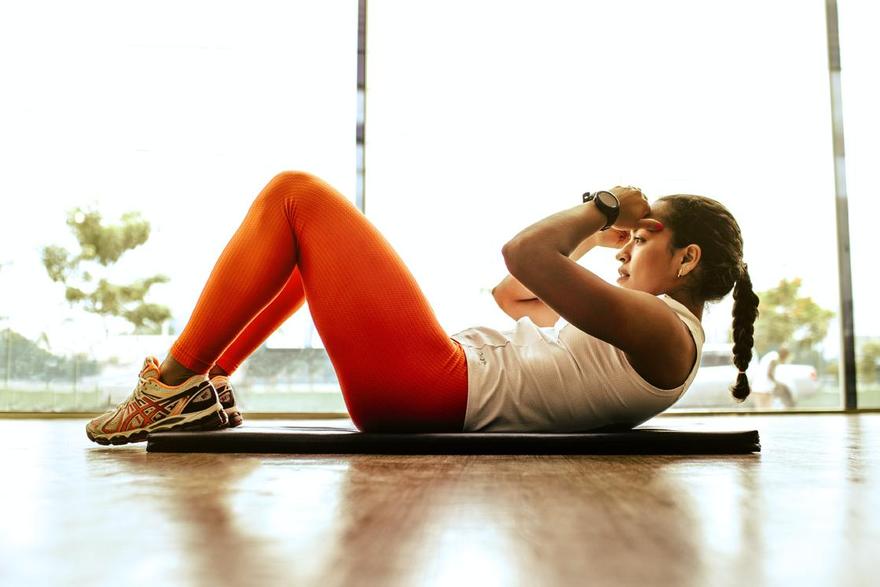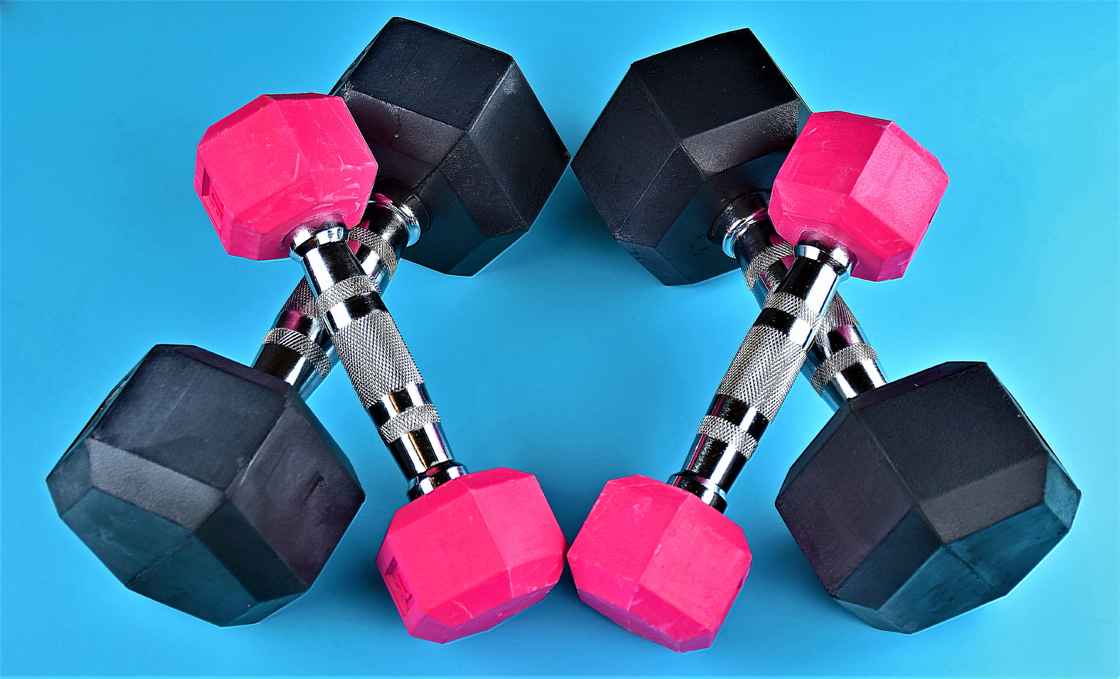
Ryan here 👋 CEO/Co-Founder of Your Hormone Balance.
I recently opened up on Instagram (HERE) about my experience doing too much vigorous exercise and high intensity interval training (HIIT) in my late 20s. I was working out harder than ever before (taking 4-5 boot camp / circuit style classes per week), but was gaining belly fat, feeling completely exhausted and LESS toned than before. Considering I dreaded these workouts AND the classes were expensive, it was depressing to experience little-to-no benefits…
It wasn’t until receiving my hormone test results and learning about the root causes behind my levels, that I realized my workouts were actually CONTRIBUTING to hormone imbalances (in my case: cortisol imbalance and estrogen dominance), PLUS, I experienced a back injury around this same time (also a result of ‘overdoing it’) that forced me to completely re-examine my approach to exercise.
Today, after much research and seeing hundreds of our clients deal with similar issues and hallmark hormone imbalances, in large part due to excessive exercise, I’ve become particularly passionate about this topic and eager to spread word to women everywhere!
Why is it that we hear all about the benefits of self care, nutrition, supplements/herbs and non toxic products for hormone balance, yet exercise is rarely examined in terms of what’s “optimal” for our hormones? We hear about the best exercise for “fat loss” (which is often H.I.I.T) – but depending on the length and frequency of the workout, this may not be beneficial or sustainable for women long term, and often contributes to hormone imbalances!
So what’s the deal with “HIIT?”
High intensity interval training is a workout style alternating between short bursts of intense exercise and short bursts of less intense exercise or rest. Activities can include sprinting, biking, jump rope, body weight exercises, swimming and boot camp style classes. Ultimately, we’re talking: high paced workouts that get the heart rate up QUICKLY.
HIIT workouts are often framed as the best for fat loss, and research has shown that they can be helpful for boosting testosterone and reducing insulin resistance / stabilizing blood sugar levels! However, depending on your stress and hormone levels, you can experience diminishing returns if you’re doing too much HIIT (4+ days per week) and/or doing lengthy sessions (over 40 mins). This can result in elevated cortisol (‘stress hormones’) and also insulin levels (i.e. insulin resistance), contributing to inflammation in the body and overstimulating the androgen hormones (testosterone and DHEA), tied to PCOS (“polycystic ovary syndrome”).
Many popular workout classes like Barry’s Bootcamp and F45 are 45-50+ mins, which is generally too intense when trying to heal and repair from hormonal imbalances, especially over 2-3 x per week! Keep in mind, many studies showing the positive benefits of HIIT training have been conducted on men and don’t take into account the hormonal ebbs and flows that a woman experiences on a daily and monthly basis.

The Impact of Vigorous Exercise (5+ days per week)
Beyond just HIIT style workouts, excessive and/or overly long workouts (5-6+ days a week, 50+ mins) can add significant stress and strain to the body- increasing cortisol levels and making it harder for your adrenal glands (which produce cortisol) to keep up with the demand for energy and keep you running on all cylinders without burning out. It is well documented that female endurance athletes / competitive athletes often experience “amenorrhea” (absent periods)- linked to low estrogen and high cortisol levels, often due to excessive exercise and under-eating.
The impact of any constant, high stress exercise can manifest in hormonal symptoms like anxiety, acne, mood swings, extreme fatigue, difficulty sleeping, irregular or missing periods, frequent sickness, low libido, allergies, scalp hair loss, facial/body hair, weight gain and belly fat (when operating from a higher stress state, the body likes to hang onto body fat as a survival mechanism).
Now we’re not saying to avoid all cardio and never do HIIT (especially if you love it), but we’re encouraging you to be strategic about when and HOW you structure your weekly workouts so that you can reap the benefits!
For example, for women of reproductive age, HIIT style workouts can be beneficial for fat loss during the follicular and ovulatory phases (kept around 20-30mins), 2-3 days max per week. But during the luteal phase (10-14 days prior to menstruation), especially during the premenstrual week and the week of your period, we recommend swapping HIIT for restorative movement (yin yoga, slow Pilates, walking) which can help reduce PMS and period pain. Women are less resilient to stress during the luteal and menstrual phases, which is another reason to avoid high-stress style exercise along with other lifestyle factors that can increase stress (too much caffeine, lack of sleep, traveling, alcohol, etc). Learn more about syncing your workouts with your cycle HERE.
So what kinds of exercise are ‘optimal’ for hormone balance?...
#1 - LOW INTENSITY RESISTANCE TRAINING (STRENGTH / WEIGHT LIFTING)
**Optimal = 2-4 x per week**
There are many forms of exercise that focus on building muscle and strength (including HIIT and many workout classes), but again, the benefits will vary greatly depending on the type, frequency and duration of the workout.
For the most hormone supportive, muscle building and fat burning routine, we encourage lifting weights and/or using bands and body weight exercises to build strength, ideally with a trainer to start (at least for 1 or 2 sessions to help you learn proper form). These types of exercises can be done in a more “low intensity” fashion – i.e. allowing enough rest between sets (2-3+mins) and not including a cardio or high intensity element between sets. The idea is to keep your heart rate stable and prevent cortisol spikes.
Now when it comes to lifting weights or body/cable exercises, one technique we love is “progressive overload” training, which means doing similar exercises each week and gradually increasing the weight, frequency, and/or number of repetitions over time. This can be beneficial with any form of exercise, but when it comes to strength training, an example would be: starting with 10lbs dumbbell curls and gradually increasing to 15 lbs in 3 weeks (or using same weight, but doing more reps), or starting with 10-12 squats and working up to 12-15 squats in 2-3 weeks, and so on. PSA: though this is a highly effective way to experience results, it’s incredibly important to gradually increase your weights and/or resistance, making sure that you’re still able to maintain proper form. The last 2-3 reps should be the hardest.
It’s also helpful to target different muscle groups on different training days – such as alternating between “upper body” and “lower body” workouts VS. doing a total body workout and exhausting the exact muscle groups day after day (which is the problem with doing back-to-back “total body” workout classes without an individualized approach). It’s important to have OFF DAYS to allow your body to rest and recover so that you can continue to progress and not plateau.
NOTE: Pilates is another great form of strength training, especially when approached intentionally (allowing rest days for muscle recovery) and working with an instructor to avoid injury.

Heavy vs. Light weights
When it comes to weight lifting, you can build muscle, burn fat and prevent lean muscle loss by lifting both heavy weights OR lighter weights – as long as you’re increasing your resistance and reps over time, allowing rest days and following a consistent plan.
Bottom line: from a hormonal perspective, the benefits of strength training / weight lifting include: boosting testosterone as well as reducing the more toxic form of testosterone, reducing excess estrogen, increasing insulin sensitivity (reducing inflammation and risks for PCOS), and relieving cortisol imbalance symptoms such as belly fat, acne, fatigue and mood swings.
As with any form of exercise, more is not necessarily better. For those dealing with hormone imbalances or hormonal conditions like PCOS, following a strength training/weight lifting program 2-3 days per week, for 30-45 mins may reap the best benefits, and will leave enough days for you to incorporate restorative movement and/or extra cardio, if you have the energy for it!
STRENGTH TRAINING RESOURCES:
For those looking for strength training workouts from home, consider investing in adjustable dumbbells, bands, and/or cables – which often come with instruction manuals to help you learn upper and lower body routines.
You can also use the below resources to find strategic weight lifting routines for women (watch the videos to learn how to properly do the movements), and/or work with a trainer for maximum support and to avoid injury!
>> 10 Week "Upper + Lower Body" Workouts for Women -(MuscleandStrength.com)
>> 8 Week Strength Training Routine (BodyBuilding.com)
>> The "Female Training Bible" (BodyBuilding.com)
^^ Don't be intimidated by how the fitness models look in the above websites. You won't look bulky from lifting weights - this is a specific look they achieve with extreme exercise and muscle boosting supplementation (which we don't recommend!). However, these workout routines are great guides to help you go into the gym with confidence and a clear plan to build strength, burn fat and tone up (which also supports hormone balance).
>> "Flipping Fifty" Strength Based Workouts HERE (perimenopause / menopause specific)
#2 - RESTORATIVE MOVEMENT
Many women have the misconception that we must do intense workouts daily to be healthy and maintain our weight, but the best thing we can do when dealing with stress and hormone imbalance is to prioritize gentle forms of movement that reduce stress, provide joy and help us recharge!
We love starting our day with a walk, going for short walks throughout the day (especially important after carb or sugar heavy meals) OR winding down with an evening stroll. Walking not only calms the nervous system, but it helps stabilize blood glucose levels, which is a helpful hack for those dealing with insulin resistance and/or PCOS.
The good news is: there’s no specific limit to restorative movement like walking, light yoga + Pilates, tai chi and stretching that calms your nervous system and keeps your cortisol levels balanced! Restorative movement is also great on rest days and pairs well with all other types of exercise (a WIN-WIN). That said, it IS possible to become obsessive about your "steps," and overdo it, especially walking 6+miles on days you've already worked out. In this case, you'll be burning a lot of calories and will need sufficient food to prevent fatigue and hormone imbalances.
RESTORATIVE MOVEMENT RESOURCES:
"Yoga with Adriene" on YouTube
@shona_vertue (yoga + mobility) on YouTube
The Core Expert App (support for all ages) by @JessicaSchatz

#3 - OPTIONAL: EXTRA CARDIO
**2-4 x per week for steady state cardio // no more than 2-3 days MAX for HIIT**
If you’re exercising purely for toning and hormone health benefits, you should still see great results from low intensity strength training and walking / yoga alone!
But if you LOVE cardio or are looking to lose excess fat, you may see faster results incorporating HIIT workouts 2-3 days per week (30mins max), and/or steady state cardio (30-45 mins, 2-4 days per week) such as running, swimming, cycling, hiking, dancing.
Just keep in mind the limitations suggested above when doing high intensity or vigorous/endurance cardio, especially if dealing with hormone imbalances such as high androgens, cortisol imbalance and/or estrogen dominance (excess estrogen relative to progesterone).
CARDIO / HIIT RESOURCES
Juice & Toya YouTube HERE and app HERE
Love Sweat Fitness app
At the end of the day, there’s no one-size-fits-all, “perfect” exercise. It’s incredibly personal to find movement you love and a routine that supports your lifestyle, mood, energy levels, etc., while also being something you can remain consistent with overtime!
We also want to acknowledge that a lot of the forms of exercise we’ve mentioned fit into more than one category, which may be a bit confusing. For example: high intensity interval training can also be considered strength training and cardio, while walking and Pilates can also be considered cardio (depending on the style / speed). But as a general rule of thumb, we find that women dealing with hormone imbalances see best results from dialing back on vigorous exercise (2-3 days per week max), prioritizing low-intensity strength / weight lifting (2-4 x per week) and regularly walking and incorporating restorative movement to benefit our mental AND physical health.
Keep in mind: pre and post workout nutrition is also KEY to sustaining energy levels during your workouts and achieving optimal results for both your physique and hormones. We recommend consuming at least 20-30 grams of protein directly after your workout to give your body the amino acids it needs to repair and build more muscle tissue. We love LSF Nutrition plant-based protein powders because they taste amazing and pack 23 grams of protein in one scoop without any additives or sugar (use code BODYBLISS15 for 15% off). Planning carb consumption around your workouts is also a great move as you’ll better utilize the glucose for energy–but always try to pair carbs with a fat and protein source (i.e. banana with nut butter and a scoop of protein powder)!
Here’s a sample week of workouts that could be supportive for you:
Monday: upper body strength training (30-45 mins)
Tuesday: walk OR yoga
Wednesday: lower body strength training (30-45 mins)
Thursday: rest day OR walk
Friday: 30min run OR circuit training
Sat: Rest day OR walk
Sun: 20 min HIIT
***
Keep in mind: even if an exercise helps you lose weight for a period of time, it may not be sustainable or hormone supportive forever. Track your energy, mood and sleep habits and cycles over time, and consider more low-intensity and restorative exercise if you’re experiencing persistent symptoms! (You can use our hormone rebalancing journal HERE to track your goals + symptoms)
Got comments or questions on this topic? Drop em below!
Interested in testing your hormone levels and getting started on an all-natural rebalancing plan? Check out our at-home hormone testing + consulting packages HERE.
